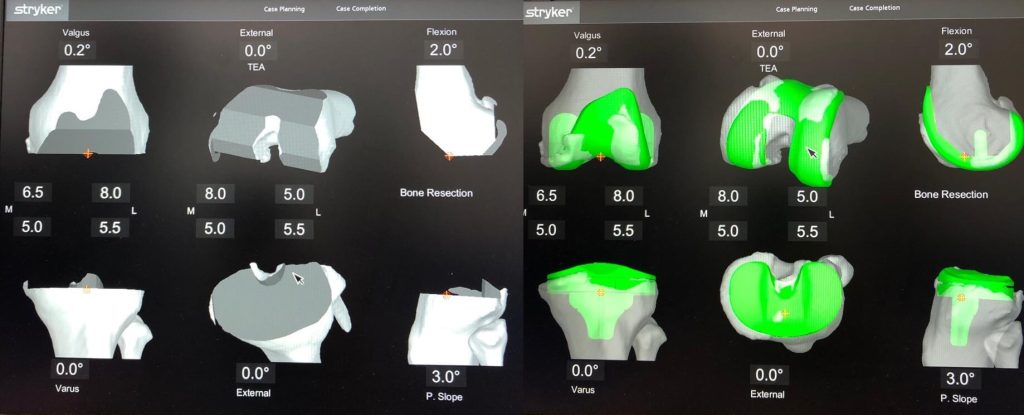Knee and hip joints facilitate the range of movement of the hip and legs.
These joints, due to their range of motion as well as the large loads placed upon them, are susceptible to the erosion processes of the cartilage tissue that coats the joint. This destruction leads to the exposure of the bone beneath the cartilage (subdural bone), the development of inflammation and pain, and the restriction of movement. Pain can be relieved with painkillers, anti-inflammatory treatments, various injections, and physiotherapy. If all the
conservative treatment methods have been exhausted, and if there is a significant functional limitation accompanied by much pain, surgical treatment to replace the injured knee and hip joint with an artificial implant that simulates the natural movement of the hip joint may be considered. This surgery is performed using a unique, robotic arm.
The robotic method of replacing the knee and hip joints enables the surgeon to balance the joint and make highly accurate bone incisions, thus achieving optimal results, both in terms of adjusting the joint to the anatomical structure of the knee and hip and in terms of recovery and a rapid return to normality.
Partial Knee Replacement
(PARTIAL KNEE REPLACEMENT, PKR)
What Is Partial Knee Replacement Surgery?
Partial knee replacement surgery is a surgical procedure in which only the injured area of the knee joint is replaced, which may reduce the trauma to healthy bones and tissues.
Thereare three types of PKR replacement:
Half-knee replacement – a surgical procedure to replace the injured section of the knee, which may be the internal (medial) or lateral (lateral) section.
Replacement of the patellofemoral compartment – a procedure for replacing the worn patella and replacing the TROCHLEA socket located at the end of the femur.
Two-pronged knee replacement – a procedure to replace two compartments in the knee, the medial compartment and the patellofemoral compartment.
The use of robotic arm technology to partially replace the knee allows for spot focus on the part of the knee that has been damaged and its replacement, without contact with the healthy bones, muscles and tendons surrounding the joint.

Total Knee Replacement
What is Total Knee Replacement Surgery?
A surgical procedure during which all damaged areas are completely replaced with a full implant. The use of robotic arm technology to completely replace the knee allows the surgery to be performed while anatomically balancing the ligaments and precise incisions of the bone, while maintaining the surrounding levels.


Hip replacement
What is hip replacement surgery?
A surgical procedure designed to replace the injured joint with an artificial implant on both sides of the pelvis- the hip bone and the pelvic socket (acetabulum) and simulates the natural movement of the hip joint. This surgery allows the patient to return to full function while maintaining a stable joint, improving the range of motion of the joint, leg length and anatomical balance of the hip joint within the pelvis.

Preparations for joint replacement surgery using a robotic arm
The patient is examined in the clinic and according to the findings of the examination and the imaging photos verify the suitability for joint replacement surgery.
There are several types of robots in Israel, most of which are excellent and allow for maximum accuracy during surgery.
In some robots, three-dimensional imaging of the knee and hip joint is performed and inserted into a computer program, with the help of which the operation is planned. In other robots, no preliminary imaging is required, except for X-rays.
At the beginning of the operation, receptors are placed around the joint, with which the robot "sees" the joint. The tension of the straps around the joint is checked by means of a special tensioner inserted into the joint and with its help "calibrate" and balance the joint to the anatomical shape while adjusting the type and size of the implant, choosing the optimal position for fit, the incision angles, and the pressures applied to the knee or hip according to the required flexion angles.
During the operation, Professor Drexler uses a robotic arm that has an advanced navigation system and dynamic systems for balancing the hip or knee joint. This technology facilitates precise incision of the bone according to the program, and prevents damage to the tissues surrounding the surgical area. The action of incision is carried out using the robotic arm controlled by Professor Drexler; robotic system has a built-in mechanism that prevents deviation from the program, and even disables its operation in the event that it occurred. At the end of surgery, the patient's body has been implanted with the most advanced implants in the world.
Using a robot to replace hip and knee joints provides several advantages at
each stage of surgery:
Preparation for surgery:
- Performing 3D imaging of the joint (depending on the type of robot).
- Planning of the surgery using a computer and a special system that facilitates selection of the implant and its anatomically optimal adaptation to the patient.
- Placement of the implant on the imaging position and at an optimal anatomical angle while planning the ranges of motion of the joint.
The course of the surgical operation:
- Precise implementation of the surgical plan.
- Optimal balance of the range of motion of the joint with an emphasis on balancing the dynamic pressure curve of the ligaments surrounding it, throughout the range of motion.
- Creating full range of the joint.
- Cutting bones safely and minimally while avoiding damage to surrounding tissues – muscles, tendons, nerves and blood vessels – so that during the
- operation the blood loss is kept to a minimum.
- Dedicated implantation, one of the most advanced implants in the world.
Post-Surgery
- Getting up and activating the new joint a few hours after surgery –
- Convenient rehabilitation process in the patient's home that facilitates a quick return to full activity.
- Relative reduction to the level of pain.


